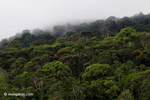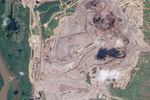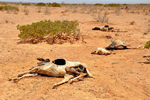Five years after being elected president and six months after winning a second term, President Obama today gave his first speech devoted solely to climate change and announced several executive actions to begin weaning the United States (historically the largest emitter of greenhouse gases) off fossil fuels. At Georgetown University today, Obama stated that his administration would expand renewable energy projects on federal lands, raise energy efficiency standards on appliances, and, most importantly, limit carbon pollution from both existing and new power plants, which represent about 40 percent of the U.S.’s emissions. Obama also noted that the U.S. would spearhead global efforts to combat climate change which is pushing sea levels higher, melting glaciers and sea ice, exacerbating fires, imperiling species, and worsening extreme weather worldwide.
“I refuse to condemn your generation and future generations to a planet that’s beyond fixing,” the president told Georgetown students. But given widespread gridlock in Congress, Obama has had to turn to executive actions through the EPA, which the Supreme Court recently ruled has the jurisdiction to regulate carbon.
“I’m directing [Environmental Protection Agency (EPA)] to put an end to the limitless dumping of carbon pollution from our power plants,” the president said.
Obama’s long-awaited plans and speech comes five years after the U.S. Senate failed to pass cap-and-trade legislation. Following the congressional failure, climate change was largely placed on the backburner for the administration until Obama’s re-election last November. Surprising many, Obama made climate change a focal point of his second inauguration speech and his State of the Union, vowing to take action on the issue—which has been almost wholly ignored by his predecessors—if Congress failed.
“Ninety-seven percent of scientists, including by the way some who originally disputed the data, have now acknowledged the planet is warming and human activity is contributing to it,” Obama said today, citing a recent study that confirmed–once again–that the vast majority of climatologists accept climate science.
Global temperatures have risen approximately 0.8 degrees Celsius (1.44 degrees Fahrenheit) over the last hundred years, but scientists expect temperatures to rise another 1.4 degrees Celsius to 5.2 degrees Celsius by 2100. Such rapid rises in global temperatures could decimate global agriculture, coastal cities, and many ecosystems.
Obama noted that his plans would come under fire from special interests and some politicians, who would argue that the actions would cripple the economy and devastate jobs. However, Obama said, that such assertions have been wrong in the past and that action on climate change will create new industrial sectors, produce clean energy jobs, and help America stay ahead in research and development.
In fact, the Speaker of the House John Boehner (Republican-Ohio) last week called Obama’s plans, which had yet to be fully released, “absolutely crazy.” Meanwhile three Republicans from Virginia called Obama’s proposals a “war on coal,” which would raise energy prices. Obama won Virginia last November by 3 percent.

Hurricane Sandy storm surge on the New Jersey shore. The massive tropical storm, the largest hurricane ever recorded in the Atlantic, renewed discussion of climate change in the U.S. media and politics. Photo by: Master Sgt. Mark C. Olsen/U.S. Air Force/New Jersey National Guard.
“We don’t have time for a meeting of the Flat Earth Society,” the president said. “Sticking your head in the sand might make you feel safer, but it won’t protect you from the coming storm.”
Before this, Obama has already done more to reduce U.S.’s greenhouse gas emissions than any president before including raising fuel efficiency standards and supporting renewable energy projects across the country.
Obama also signaled that the administration would continue to work with every nation to tackle the global issues. In pursuing energy sources, the president said, “[developing countries] don’t have to repeat all the same mistakes we’ve made.” He called on public financing to avoid supporting any new coal plants overseas unless no other viable options were available or the plants used carbon capture technology. The World Bank has recently made a similar commitment.
As to the controversial Keystone Pipeline, which would carry tar sands oil from Alberta, Canada to the Gulf Coast, Obama said that the pipeline would not be approved if it worsens climate change: “our national interest will be served only if this project does not significantly exacerbate the problem of carbon pollution.” According to research, oil burned from the tar sands emits significantly more carbon than conventional oil.
“The hard truth is carbon pollution has built up in our atmosphere for decades now, and even if we Americans do our part, the planet will slowly keep warming for some time to come,” Obama went on to say, “the seas will slowly keep rising; the storms will get more severe, based on the science. It’s like tapping the brakes of a car before you come to a complete stop and then shift into reverse. It’s going to take time for carbon emissions to stabilize.”
Still many environmentalists and scientists say that Obama’s plans, while a step in the right direction, do not go far enough.
Saleemul Huq, a senior fellow with the International Institute for Environment and Development’s Climate Change Group, said the administrations plans were “too little, too late.”
“While it is good to see a leader of the world’s richest country and biggest cumulative polluter finally promise to take actions, after over a decade of refusal to do so, the problem has become much bigger while the US was ignoring it,” he stated. “Hence the world is now headed towards 4-degree temperature rise by 2100 unless much more drastic actions are undertaken on mitigation by all countries including the United States. President Obama says he wants the U.S. to lead this effort globally. His promise is welcome, but his actions still fall short of what is required.”
Obama has pledged to cut U.S. emissions by 17 percent from 2005 levels by 2020. While a much-less ambitious cut than the EU has put forward, he is the first U.S. president to set such a goal.
“As a president, as a father, and as an American, I’m here to say we need to act,” Obama said.

U.S. carbon emissions are second only to those of China. Historically, the U.S. is the world’s largest carbon emitter. To date, the U.S. has no federal legislation to reduce its carbon emissions. Click image to enlarge.
Related articles
Seabirds face big problems as sea levels rise

(06/19/2013) Migratory shorebird populations are at great risk from rising sea levels due to global climate change, warns a recent paper in Proceedings of the Royal Society B. These birds play an important role in the distribution of nutrients within wetland and coastal ecosystems, and their loss could have unknown consequences for the rest of the world.
Warming world hits fig wasps and figs

(06/19/2013) Recent experiments concerning hugely-important fig plants (Ficus) and their relationship with small, short-lived fig wasps suggest dire potential consequences due to human induced climate change, finds a study published in the journal Biology Letters. The researchers collected four species of adult female fig wasps from the lowland tropical forests of Singapore to test their tolerance to gradually increased temperatures.
Should zoos educate the public about climate change?

(06/18/2013) Zoos are usually thought of as entertainment destinations. As a place to take the kids on a nice afternoon, they are sometimes perceived to lack the educational heft of an art museum or a theatre. However, over the past few decades many of the world’s best zoos and aquariums have also worked to educate their visitors about conservation issues, in addition to funding and supporting programs in the field to save the ever-growing number of imperiled species. But as threats to the world’s species mount—including climate change—many are beginning to ask what, if anything, zoos and aquariums should do to address the global environmental crisis.
Rainforests will survive extreme global warming, argues study

(06/02/2013) Rainforests in South America have endured three previous extreme global warming events in the past, suggesting they will survive a projected 2-6 degree rise in temperatures over the coming century, reports a study published in the Annual Review of Earth and Planetary Science. The research, published by Carlos Jaramillo and Andrés Cárdenas of the Smithsonian Tropical Research Institute (STRI) in Panama, reviewed some 3,800 published estimates of temperature over the past 120 million years and compared them to the existence of tropical plants in the fossil record.
Millennium Development Goals falling short on environmental ambitions
(05/30/2013) This week in New York City, the 27 members of the high-level panel of eminent persons appointed by the U.N. Secretary General will deliver a report providing recommendations on the post-2015 development agenda. This is a critical opportunity to address the inadequacies of the Millennium Development Goals (MDGs) and to chart a new course for sustainable development.
Earth likely to warm between 2 and 6 degrees Celsius this century
(05/30/2013) A new study by Australian scientists projects that the world will likely warm between 2 and 6 degrees Celsius (3.6 to 10.8 degrees Fahrenheit) from pre-industrial levels by 2100. The study published in Nature Climate Change finds that exceeding the 2-degree threshold is very likely under business-as-usual emissions scenarios even as scientists have long warned that passing the 2-degree mark would lead to catastrophic climate change.
Over 500 scientists warn we ‘are causing alarming levels of harm to our planet’
(05/27/2013) A new consensus statement by 520 scientists from around the world warns that global environmental harm is putting at risk the happiness and well-being of this and future generations.
Indonesia’s largest coal plant will be built despite protests, minister says
(05/26/2013) Indonesia will go ahead with construction of what is set to be its largest coal-fired power plant in Batang, Central Java next year, a senior government official has said, downplaying opposition from environmental groups and the local community. Developers have struggled to acquire the approximately 200 hectares of land needed for the planned PLTU Batang plant, which would have a 2000 megawatt (MW) capacity. Residents of five villages have protested the project, with some refusing to release their land on fears of potential environmental damage to the area. Environmental groups also oppose the plant, saying it overlaps with a marine protected area and runs counter to President Susilo Bambang Yudhoyono’s commitment to reduce carbon emissions.
China to begin cutting carbon emissions one city at a time
(05/23/2013) China has unveiled details of its first pilot carbon-trading program, which will begin next month in the southern city of Shenzhen. The trading scheme will cover 638 companies responsible for 38% of the city’s total emissions, the Shenzhen branch of the powerful National Development and Reform Commission (NDRC) announced on Wednesday. The scheme will eventually expand to include transportation, manufacturing and construction companies.
Biosphere conservation: monumental action is critical to avert global environmental crisis

(05/20/2013) Human-caused changes to our biosphere—the global total of the world’s ecosystems—are now so great and alarmingly rapid that human lives and societies undoubtedly face epic challenges in the near future as our biosphere deteriorates, planetary boundaries are reached, and tipping points exceeded. We may survive, we may painfully adapt, but it is a fair bet that grave hardship, loss, and sacrifice lay ahead. The nature and extent of impacts among human populations hinges on how successfully we respond to the biosphere crisis with extraordinary leadership, balanced solutions applied at global scales, and unprecedented cooperation—or not.
Scientists have reached an overwhelming consensus on human-caused climate change

(05/16/2013) Despite outsized media and political attention to climate change deniers, climate scientists long ago reached a consensus that not only is climate change occurring, but it’s largely due to human actions. A new study in Environmental Research Letters further strengthens this consensus: looking at 4,000 peer-reviewed papers researchers found that 97 percent of them supported anthropogenic (i.e. human caused) global warming. Climate change denialists, many of them linked to fossil fuel industries, have tried for years—and often successfully—to undercut action on mitigating climate change through carefully crafted misinformation campaigns.
Canadian government drops over $16 million on advertising its tar sands

(05/16/2013) The Canadian government has nearly doubled its advertising spending to promote the Alberta tar sands in an aggressive new lobbying push ahead of Thursday’s visit to New York by the prime minister, Stephen Harper. The Harper government has increased its advertising spending on the Alberta tar sands to $16.5m from $9m a year ago.
(05/15/2013) With islands and atolls scattered across the ocean, the small Pacific island states are among those most exposed to the effects of global warming: increasing acidity and rising sea level, more frequent natural disasters and damage to coral reefs. These micro-states, home to about 10 million people, are already paying for the environmental irresponsibility of the great powers.
Mount Everest glaciers have shrunk 13% in 50 years
(05/13/2013) Glaciers in the Mount Everest region have shrunk by 13 percent and the snow-line has shifted 180 meters (590 feet) higher during the past 50 years, according to a study that will be presented this week at a conference organized by the American Geophysical Union.
Climate change to halve habitat for over 10,000 common species
(05/13/2013) Even as concentrations of carbon dioxide in the atmosphere hit 400 parts per million (ppm) for the first time in human history last week, a new study in Nature Climate Change warns that thousands of the world’s common species will suffer grave habitat loss under climate change.
Last time CO2 hit 400 ppm, temperature was 8C warmer, seas 40m higher than today
(05/12/2013) The future of a globally warmed world has been revealed in a remote meteorite crater in Siberia, where lake sediments recorded the strikingly balmy climate of the Arctic during the last period when greenhouse gas levels were as high as today.
A new world?: carbon dioxide concentrations in atmosphere hit 400 ppm

(05/11/2013) For the first time since homo sapiens evolved, concentrations of carbon dioxide in the atmosphere have struck 400 parts per million (ppm) due to burning fossil fuels. The National Oceanic and Atmospheric Administration (NOAA) reports that readings of carbon dioxide at Mauna Loa Observatory in Hawaii hit the symbolic number on Thursday and are expected to continue rising in coming years. The last time concentrations were this high for a sustained period was 4-5 million years ago when sea levels were 5-40 meters higher than today and the poles were 10 degrees Celsius hotter. During this epoch, forests grew along the shores of the Arctic Ocean and coral reefs were almost wholly absent.
Featured video: How climate change is messing with the jetstream
(05/08/2013) Weather patterns around the globe are getting weirder and weirder: heat waves and record snow storms in Spring, blasts of Arctic air followed by sudden summer, record deluges and then drought.
The Hawaiian silversword: another warning on climate change

(05/06/2013) The Hawaiian silversword (Argyroxyphium sandwicense), a beautiful, spiny plant from the volcanic Hawaiian highlands may not survive the ravages of climate change, according to a new study in Global Change Biology. An unmistakable plant, the silversword has long, sword-shaped leaves covered in silver hair and beautiful flowering stalks that may tower to a height of three meters.
‘Suffering…without witnesses’: over a quarter of a million people perished in Somali famine

(05/06/2013) A new report estimates that 258,000 people died in 2011 during a famine in Somalia, the worst of such events in 25 years and a number at least double the highest estimations during the crisis. Over half of the victims, around 133,000, were children five and under. The report, by the UN Food and Agricultural Organization (FAO), argues that the international community reacted too late and too little to stem the mass starvation brought on by government instability, conflict, high food prices, and failed rains, the last of which has been linked to climate change by some scientists.